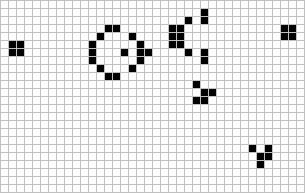Java implementation by Michael Romashov
Created for an AP Computer Science A project
After you download and run the Java archive provided, you will be greeted with a black screen. Below are the different keybinds you can use to create and run your own structures!
| Keybind | Function |
|---|---|
| Left Mouse | Paint live cells, Place active blueprint |
| Right Mouse | Paint dead cells (eraser) |
| 1 | Create a Gosper Glider Gun blueprint |
| 2 | Create a Pufferfish blueprint |
| R | Rotate blueprint |
| Space | Manually step through generations |
| Shift + Space | Automatically run through generations (20 generations per second) |
| Enter | Stop automatically running through generations |
Disclaimer: This is, in no way, a comprehensive explanation of Conway's Game of Life. THere are definitely things I missed and there may be things I got wrong. If you want to add on or correct my explanation, feel free to submit a pull request.
To understand what Conway's Game of Life is, we must first understand what a cellular automata is. A ceullar automata is a model that describes how an array of cells "evolves" every iteration of the model. Simply put, imagine a grid of cells where each cell is either alive or dead. Each iteration of the model, we use apply a specific set of rules to each cell in the grid to determine its next state. These rules are usually simple "yes" or "no" questions regarding the cell's neighbors, but is not limited to that. Every iteration, or generation of the model, the cells evolve and can form different structures such as the ones seen below (in the examples below, every next row is a new generation).
Conway's Game of Life is a form of cellular automata, with its own set of rules. The rules that John H. Conway created are as follows:
- Any live cell with fewer than two live neighbours dies, as if by underpopulation.
- Any live cell with two or three live neighbours lives on to the next generation.
- Any live cell with more than three live neighbours dies, as if by overpopulation.
- Any dead cell with exactly three live neighbours becomes a live cell, as if by reproduction.
When cells are randomly set to be live, you will notice that the model tends to be chaotic, with the cells changing state with what seems to be a random rate or pattern. However, given enough generations pass, every cell will stabilize and turn into one of the strucures below.
A still life is a structure that does not change in the next generation. They are said to be stable structures. Pictured below are the Block and Beehive.
An oscillator is a structure that alternates between multiple states before returning to a previous state and starting the loop again. Here we introduce the idea of a period, which is the amount of generations it takes a structure to return to a previous state and cycle through its states again. For example, the Blinker (left) has a period of 2, meaning it loops through all of its states every 2 generations. The Queen Bee Shuttle (right) has a period of 30.
A spaceship is a structure that moves after a certain amount of generations. Picture below are the Glider (left; period 4) and the Lightweight Spaceship (right; period 4).
A gun is a structure that generates spaceships, as if shooting them outward in a constant stream. Guns generate a spaceship at a constant rate. For example, the Gosper Glider Gun pictured below creates a glider every 30 generations (period 30). (You may notice that the Gosper Glider Gun is very similar to the Queen Bee Shuttle pictured earlier, thats because it acts as the base for the glidern gun!).
Okay so now that we are at least somewhat familiar with this interesting cellular automaton, lets see how far we can take it!
An eater is a specific structure, usually a still life, that when collided by a spaceship, will destroy the spaceship while remiaining intact. Below is an example of a eater specifically made to destroy Gliders.
If two spaceships are positioned correctly, they can actually annihilate each other! When this happens, both gliders completely die. Pictured below is the annihilation of two Gliders.
If used correctly, annihilation and eats can actually be used to create Turing complete computers! This video does an excellent job of explaining and demonstrating this. Somebody even used Game of Life to create a fully functioning model that simulates the Game of Life... INSIDE THE GAME OF LIFE! A video demonstrating this can be found here.








